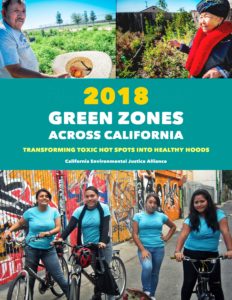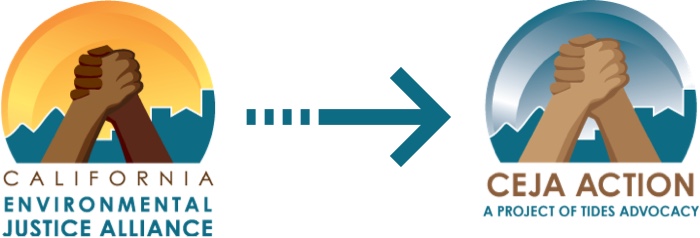CEJA Releases New Green Zones Report
Green Zones: Transforming Toxic Hot Spots into Healthy and Thriving Neighborhoods
CEJA is proud to announce the release of its newest Green Zones Across California report for 2018! This updated 36-page report highlights nine Green Zones case studies led by residents and community-based organizations from different environmental justice communities across California.
What is a Green Zone?
All across California, low-income residents and communities of color are leading the way by achieving their desired vision for their neighborhoods. United in their efforts, they are bringing in much-needed improvements such as parks and community-owned farms, affordable housing with pedestrian pathways and bikeways, accessible transit options that increase connectivity, and high quality jobs with benefits for local residents–all while fighting off the historic and cumulative threats their health such as industrial sources of pollution that have contaminated their air, water and soil.
Highlights from the updated 2018 report include:
- The most recent Green Zones initiatives and campaign wins: From CCAEJ’s campaign against Omnitrans in the Inland Valley, to the Forgotten Voices Campaign led by CRPE in South Kern County, each case study includes the most campaign updates and new projects led by each community.
- Green Zones legislative victories: In 2016, CEJA successfully got AB 2722 (Burke) and SB 1000 (Leyva) passed into law. Our most recent report shares the road to those victories and how each law advances our vision for Green Zones across California.
- An interview with two Green Zones co-founders: We are honored to have Diane Takvorian (EHC) and Antonio Diaz (PODER) share their highlights and reflections on the progression of the Green Zones initiative over the years.
- New community profiles: CEJA is excited to highlight recent work by the 500 Feet Collaborative in South Central Los Angeles, and profiles of green business through the Clean Up Green UP (CUGU) campaign
More about Green Zones
Green Zones are place-based strategies that use community-led solutions to transform areas overburdened by pollution into healthy and thriving neighborhoods. Each community vision has developed out of decades of organizing by those living and working in these communities that have experienced an over-concentration of polluting facilities and toxic emissions in their areas. These problems are the result of unhealthy — and often discriminatory — land use planning decisions that have shaped how our communities look and feel over the years.
While each Green Zone reflects the unique needs, priorities, and environmental justice issues of each neighborhood, all share common roots. All local Green Zones initiatives build upon the following principles:
- Comprehensive: The Green Zones Initiative shifts away from fighting community health threats one by one to a more comprehensive approach based on principles of justice and sustainability. Each Green Zone uses a holistic vision for neighborhood transformation, which is grounded in the voice of local residents.
- Community-Based: Green Zones are grounded in an authentic, community-based planning process that gives residents an opportunity to articulate the need and vision for their neighborhoods. This creates a clear platform of community-identified priorities, amplifies the voice of residents, and provides a road map for Green Zone development.
- Solution Oriented: Green Zones don’t just fight the bad, they also bring in the good. Green Zone campaigns advance multiple solutions that reflect the interconnected issues on the ground and residents’ visions for change.
- Collaborative: Green Zones seek to implement multiple transformative changes that no one organization can achieve alone. Green Zones utilize unique partnerships such as task forces, working groups, coalitions, and alliances to link community-based organizations with local, state, and federal agencies to achieve a community-led vision.


